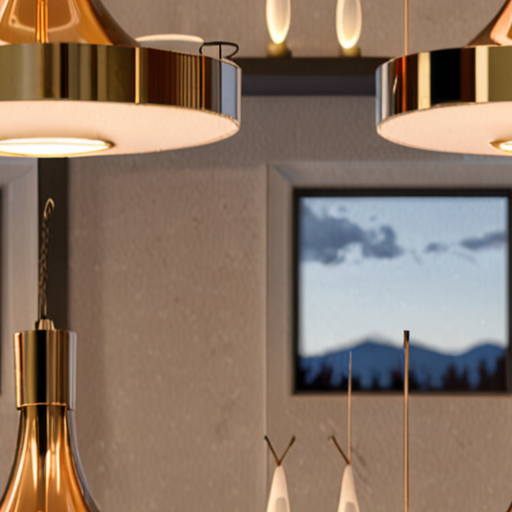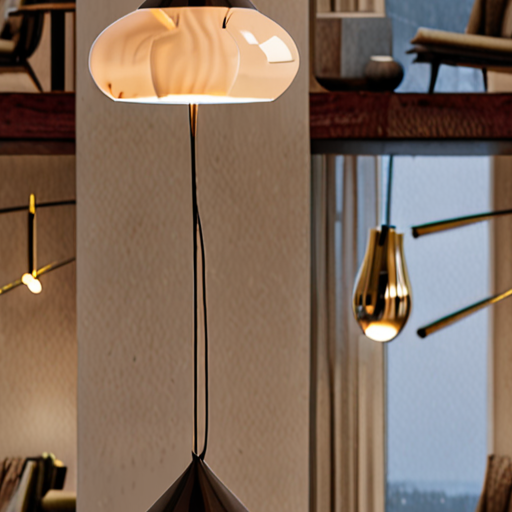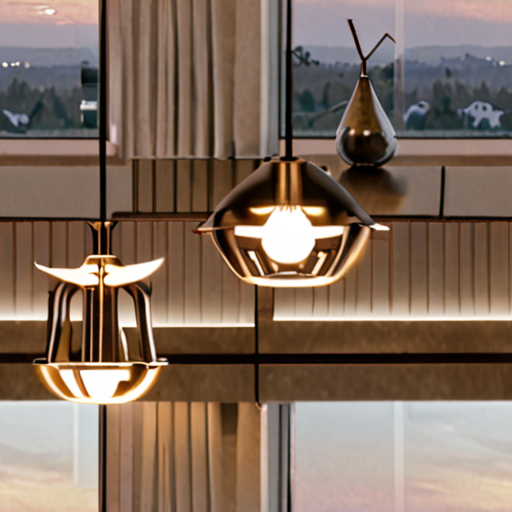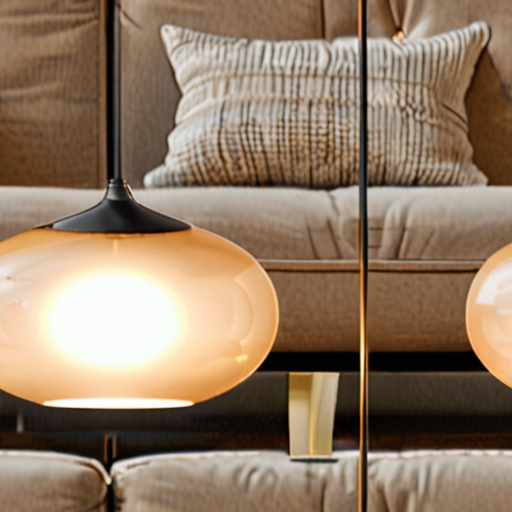As homeowners continue to prioritize both form and function in their living spaces, one often-overlooked aspect of home improvement comes into focus: updating home lighting fixtures. Not only do outdated fixtures detract from a room’s aesthetic appeal, but they can also lead to wasted energy and decreased safety. By investing in modern, energy-efficient lighting solutions, homeowners can significantly enhance their home’s ambiance, value, and overall livability.

Update Your Home Lighting Fixtures for Maximum Energy Efficiency and Ambiance
Elevate your space with smart updates! Learn how to upgrade your outdated lighting fixtures for maximum energy efficiency and create a warm, inviting ambiance that enhances your home’s style.
-
Assess Your Current Lighting
Determine which lighting fixtures are outdated, inefficient, or simply not meeting your needs. Take note of the types of bulbs currently used, their wattage, and the overall aesthetic appeal of each fixture.
-
Select Energy-Efficient Options
Choose LED bulbs, which consume significantly less energy than traditional incandescent bulbs. Consider smart light bulbs that can be controlled remotely and adjust brightness levels automatically.
-
Consider Smart Lighting Systems
Invest in a smart lighting system that integrates with your home’s automation hub. These systems allow for seamless control, scheduling, and adjustment of lighting levels based on your preferences and daily routines.
-
Add Ambient Lighting Elements
Incorporate table lamps, floor lamps, or string lights to create cozy reading nooks, accentuate architectural features, or add warmth to outdoor spaces.
-
Hire a Professional for Installation
If unsure about installing new lighting fixtures or upgrading existing ones, consider hiring a licensed electrician to ensure safe and efficient installation.
-
Explore Local Rebates and Incentives
Research local utility companies, governments, or organizations offering rebates, tax credits, or other incentives for energy-efficient upgrades.
By implementing these steps, you’ll not only enhance your home’s ambiance but also reduce energy consumption and lower your utility bills.
Additional Tips:
- Regularly clean and dust lighting fixtures to maintain optimal performance and longevity.
- Consider using dimmers or smart switches to further optimize energy usage and customize lighting settings.
- Take advantage of energy-saving features offered by smart lighting systems, such as automatic shut-off or scheduled lighting adjustments.
Recommended Resources:
- U.S. Department of Energy – Energy Saver
- U.S. Environmental Protection Agency – Green Homes
- Lutron Electronics Co., Inc.
Update Old Light Fixtures Without Breaking the Bank
Elevate your space without overspending – discover simple and cost-effective ways to update old light fixtures in your home.
-
Diy Projects
Give your old light fixtures a fresh new look with these budget-friendly DIY projects:
- Paint or refinish existing fixtures to match your home’s decor
- Add new shades or glass covers to update the look
- Replace outdated switch plates and outlet covers
-
Affordable Fixture Swaps
Swap out old fixtures for new ones without breaking the bank:
- Shop second-hand stores or online marketplaces for gently used fixtures
- Consider energy-efficient LED bulbs to reduce costs
- Look for sales or discounts on new fixtures at local hardware stores
-
Lighting Hacks
Get creative with lighting hacks to update your space without spending a fortune:
- Use string lights or fairy lights to add ambiance
- Install a dimmer switch to control lighting levels
- Utilize mirrors to reflect light and create the illusion of more space
-
Smart Lighting Solutions
Upgrade to smart lighting systems for a modern and efficient look:
- Invest in smart bulbs that can be controlled remotely
- Install a smart lighting hub for seamless integration
- Explore voice-controlled lighting options for added convenience
-
Additional Tips
Remember to always follow safety guidelines when working with electricity:
- Turn off power to the circuit before starting any work
- Use protective gear, such as gloves and safety glasses
- Consult a professional if unsure about any aspect of the process

Top Considerations for Updating Home Lighting
When deciding how to update your home lighting to achieve a modern look while maintaining functionality, there are several key factors to consider. As a homeowner, you want to create a space that is both stylish and practical, and the right lighting can make all the difference. Here are some essential tips to keep in mind:
- Assess Your Space
Before you start shopping for new light fixtures, take some time to assess your space. Think about the layout of your rooms, the type of activities that take place there, and the overall aesthetic you want to achieve. This will help you determine what types of lighting you need and where to install them.
Lighting Types
There are several types of lighting to choose from, each with its own unique benefits and drawbacks. Some popular options include:
- Overhead Lighting
Overhead lighting is great for general illumination and can be installed in a variety of locations, including ceilings, walls, and even floors.
Table lamps are perfect for task lighting and can be placed on tables, desks, or shelves to provide focused lighting.
Floor lamps are versatile and can be used for both task and ambient lighting. They’re often taller than table lamps and can be placed in corners or against walls.
String lights are a great option for adding ambiance to a room. They come in a variety of styles and can be hung from ceilings, walls, or even trees.
Lighting Fixtures
When choosing lighting fixtures, consider the style and material of your furniture and decor. You’ll want to select fixtures that complement these elements and enhance the overall aesthetic of your space. Some popular materials include:
- Metal
Metal lighting fixtures are durable and easy to clean. They come in a variety of finishes, including chrome, brass, and bronze.
Glass lighting fixtures are elegant and sophisticated. They can add a touch of glamour to any room and come in a range of styles, from modern to traditional.
Ceramic lighting fixtures are a great option for those who want a more rustic or vintage look. They’re often handmade and can add a unique touch to a room.
Energy Efficiency
When updating your home lighting, don’t forget to consider energy efficiency. Look for fixtures that are Energy Star certified and use LED bulbs, which are more energy-efficient than incandescent bulbs. You can also consider installing smart lighting systems that can be controlled remotely and adjust brightness levels automatically.
Additional Tips
Here are a few more things to keep in mind when updating your home lighting:
- Consider Dimming
Dimming allows you to adjust the brightness level of your lighting fixtures, which can be useful for tasks like reading or watching TV.
Color temperature refers to the warmth or coolness of light. Warm white light is often associated with relaxation, while cool white light is better suited for task-oriented activities.
Outdoor lighting can enhance the curb appeal of your home and provide safety and security features like motion-sensitive lights. Consider installing solar-powered lights or those with timers to save energy.
Final Thoughts
Updating your home lighting can seem daunting, but by considering these key factors, you can create a space that is both stylish and functional. Remember to assess your space, choose the right lighting types and fixtures, and prioritize energy efficiency. With a little planning and creativity, you can achieve a modern look that meets your needs and enhances your lifestyle.
Updating Home Lighting for a Seamless Transition
As a homeowner, upgrading your home lighting can seem like a daunting task, but with the right approach, it can be a seamless process.
- Step 1: Assess Your Current Lighting Needs
- Step 2: Choose Energy-Efficient Options
- Step 3: Plan Your Upgrade
- Step 4: Hire a Professional (If Necessary)
- Step 5: Install New Fixtures
- Step 6: Test and Adjust
- Step 7: Consider Smart Home Integration
- Step 8: Maintain and Update Regularly
- Step 9: Explore Rebates and Incentives
- Step 10: Enjoy Your New Lighting
Determine which areas of your home need the most attention, considering factors such as natural light, room purpose, and personal preferences.
Select lighting fixtures that meet your needs and are energy-efficient, such as LED bulbs or smart lighting systems.
Create a budget and timeline for your upgrade, considering factors such as labor costs, materials, and potential disruptions to daily life.
If you’re not comfortable with electrical work or have complex lighting needs, consider hiring a licensed electrician to assist with the upgrade.
Install your new lighting fixtures, following manufacturer instructions and taking necessary safety precautions.
Test your new lighting setup and make adjustments as needed to ensure optimal performance and energy efficiency.
Explore options for integrating your new lighting with smart home systems, allowing for remote control and scheduling capabilities.
Schedule regular maintenance checks to ensure your lighting remains energy-efficient and functional, and update your setup as needed to stay current with the latest technologies.
Research local rebates and incentives for energy-efficient lighting upgrades, potentially saving you money on your upgrade.
Relax and enjoy the benefits of your updated home lighting, knowing you’ve made a positive impact on your energy consumption and overall living space.
By following these steps, you’ll be well on your way to a seamless transition to modern, energy-efficient home lighting.
At Peck and Gartner , we understand the importance of energy-efficient lighting and offer a range of resources and expertise to support your upgrade journey.
For more information on energy-efficient lighting and home upgrades, visit our website or consult with a professional electrician to determine the best course of action for your specific needs.
Update Your Home Lighting to Match Your Personal Style
As a homeowner, you want your space to reflect your unique personality and style, while also being energy-efficient and valuable.
- Evaluate Your Current Lighting
- Select Energy-Efficient Options
- Consider Smart Home Automation
- Add Ambient Lighting
- Integrate Lighting into Your Decor
- Hire a Professional for Complex Installations
- Explore DIY Projects and Tutorials
- Monitor and Adjust Your Lighting
Determine which areas of your home need lighting updates and consider factors such as natural light, room purpose, and furniture placement.
Choose LED bulbs, smart lighting systems, and dimmers to reduce energy consumption and increase home value.
Invest in smart home devices that allow you to control lighting remotely, schedule lighting scenes, and receive energy usage reports.
Incorporate table lamps, floor lamps, and string lights to create warm and inviting ambiance in various rooms.
Select fixtures and shades that complement your home’s architectural style and decor, such as modern pendant lights or rustic chandeliers.
Consult with a licensed electrician for complex lighting installations, such as recessed lighting or outdoor lighting systems.
Find inspiration and step-by-step guides online or in home improvement books to tackle smaller lighting projects yourself.
Regularly review your lighting setup and adjust as needed to ensure optimal energy efficiency and aesthetic appeal.
Maximize Energy Savings and Home Value
By incorporating these tips into your home lighting plan, you can enjoy a more stylish, efficient, and valuable living space.
Additional Resources:
For more information on home lighting and energy efficiency, visit our website at Peck and Gartner .
Discover the latest trends and expert advice on home renovation and design at Houzz .
Learn about energy-efficient lighting options and smart home automation at Energy.gov .

Essential Steps to Take Before Updating Your Home Lighting
Before updating your home lighting, it’s essential to consider several factors to ensure a successful and stress-free transformation.
-
Assess Your Lighting Needs
Determine the purpose of your updated lighting, whether it’s for ambiance, task lighting, or energy efficiency. Consider the rooms you want to update and the types of lighting fixtures you’ll need.
-
Evaluate Your Budget
Set a realistic budget for your lighting update, considering the cost of materials, labor, and potential electrical upgrades. Research local contractors and suppliers to get quotes and compare prices.
-
Choose Energy-Efficient Options
Select lighting fixtures that meet your needs and are energy-efficient. Look for LED bulbs, smart lighting systems, and dimmers to reduce energy consumption and save money on utility bills.
-
Consider Smart Home Integration
If you have a smart home system, choose lighting fixtures that can integrate seamlessly with your existing setup. This will allow you to control your lights remotely and adjust settings based on your preferences.
-
Plan for Electrical Upgrades
If you’re installing new lighting fixtures, you may need to upgrade your electrical infrastructure. Consult with a licensed electrician to determine if any upgrades are necessary and plan accordingly.
-
Research Local Building Codes and Regulations
Familiarize yourself with local building codes and regulations regarding lighting installations. Ensure that your chosen fixtures comply with these requirements to avoid costly rework or fines.
-
Prepare Your Space
Clear the area around the work zone, cover furniture and floors, and remove any obstacles that could interfere with the installation process.
-
Hire a Licensed Electrician
Employ a qualified electrician who has experience with lighting installations. They will ensure that the job is done safely and efficiently, meeting local building codes and regulations.
-
Test and Inspect Your New Lighting
Once the installation is complete, test your new lighting to ensure it’s working correctly. Inspect the fixtures and wiring to guarantee they meet safety standards.
-
Maintain Your Lighting System
Schedule regular maintenance checks to ensure your lighting system continues to function optimally. Replace bulbs, clean fixtures, and update software as needed to keep your lighting system running smoothly.
Conclusion:
By following these essential steps, you’ll be well-prepared for a successful and stress-free home lighting update. Remember to assess your lighting needs, evaluate your budget, and choose energy-efficient options to ensure a seamless transition to your new lighting system.

0 Comments